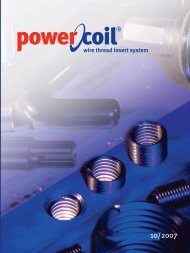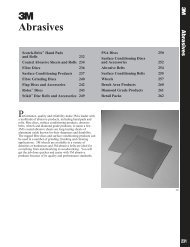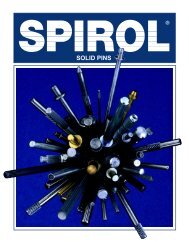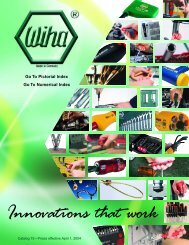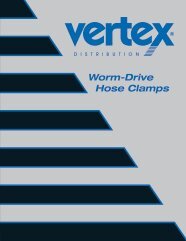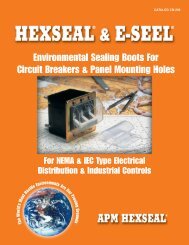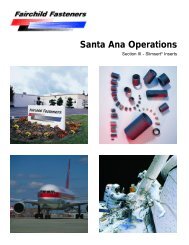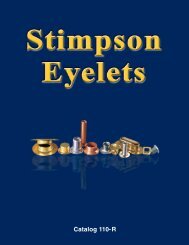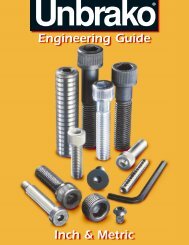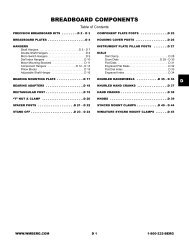Nitrogen Gas Springs and Accessories - Electronic Fasteners Inc
Nitrogen Gas Springs and Accessories - Electronic Fasteners Inc
Nitrogen Gas Springs and Accessories - Electronic Fasteners Inc
Create successful ePaper yourself
Turn your PDF publications into a flip-book with our unique Google optimized e-Paper software.
Useful Tips for the Selection, Installation, Use <strong>and</strong> Servicing of Raymond <strong>Gas</strong> <strong>Springs</strong>SelectionThe first step in proper spring selection is to identifythe total force required for your application. The nextstep is to determine the number of springs needed toprovide an even distribution of the pressure. Dividingthe total force by the number of springs yields the forcerequired per spring. It is good design practice to selecta spring whose maximum initial contact force is 20%greater than the force actually needed. The reason is,if more pressure than originally calculated is needed,the spring’s force can be increased instead of havingto redesign the system using a larger model.The UniForce System allows you to continually monitor<strong>and</strong> adjust the hosed system pressure. If the part to beproduced is complicated <strong>and</strong> the force needed is notclear, the use of an adjustable hosed UniForce Systemcan save time during tryout. Also, if the consistency ofthe stock material is poor, the UniForce System canquickly adjust the systems force as the stock materialthickness varies.Installation• Avoid side loading the piston rod. Maximumdeviation is 9 minutes.• Consult Raymond if die lubricants are to be used.• Bore hole diameters about 2 mm larger than springbodies.• Ensure the bottom of the bore is flat <strong>and</strong> square tothe sides.• <strong>Springs</strong> can be mounted in any position as long asaxial loads are avoided.• Piston rods can be preloaded in their home position.• Design using no more than 95% of the availablestroke.• Hardened striker plates are recommended for 3/4tons <strong>and</strong> upward.• Large springs installed using mountings should besafety wired.• If hoses are used, watch sharp edges <strong>and</strong> hoseminimum bend radius.• Always provide ample clearances for spring bodies.• Do not alter the piston rod, cylinder or guide in anymanner.Usage Guidelines• Always protect the surface of the piston rod fromscratches, dents <strong>and</strong> fine grinding dust.• Maximum velocity is 35 meters per minute.(115 ft per min).• Maximum frequency varies by model <strong>and</strong> strokelength; consult Raymond technical assistance formaximum values.• Maximum operating temperature is 180°F (80°C).If higher, consult Raymond technical assistance formaximum values.• Static leakage is approximately 2-3% per year(self-contained).• Continuous operation is permissible.• If die lubricants are to be used, consult Raymondtechnical assistance.• Periodically remove the spring from the application<strong>and</strong> check for unusual force gain or loss.MaintenanceAfter a gas spring has exceeded its first life, it can berebuilt to a “like new” condition. Raymond rebuilt versionsyield a life equal to that of a new spring. Simplysend back your used spring to Raymond <strong>and</strong> we willdo the rebuild work for you! Repair kits <strong>and</strong> instructionscan also be purchased which allows you to rebuild thesprings. All Raymond nitrogen springs are rebuildableexcept the RD disposable models.For self-contained users: It is recommended tokeep a log of the spring part numbers used in eachdie. This log should also track the numbers of hits onthe die since the spring was last serviced. The springshould be periodically removed <strong>and</strong> checked for forceby either the test bench or the replenishing armature.UniForce system users: Maintaining a hosesystem requires the same record keeping used forself-contained springs, except for the following differences.All springs connected in a system will haveexactly the same pressure at all times. When aspring(s) suffers leakage, the entire system will indicatea loss of pressure. In order to correct the leakageproblem, it will be necessary to remove the die fromthe press, drain the remaining pressure <strong>and</strong> removethe springs. If, before draining the remaining pressure,oil or soap <strong>and</strong> water is applied directly around thepiston rods, the leaking springs will identify themselves.It is possible the system only leaks when thepiston rods are depressed, but such a problem is normallydetected by visually inspecting the surface of thepiston rods. This method may not be as high-tech as asegregated modular control panel, but it will lower yourinitial investment. If springs must be segregated due toa required force variance in the same die, two or morest<strong>and</strong>ard control panels can be employed.




